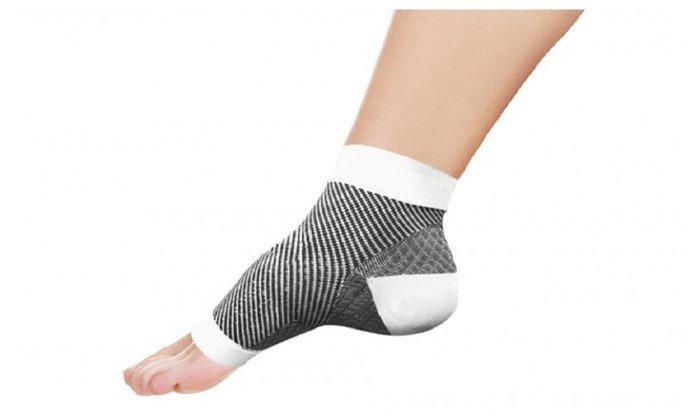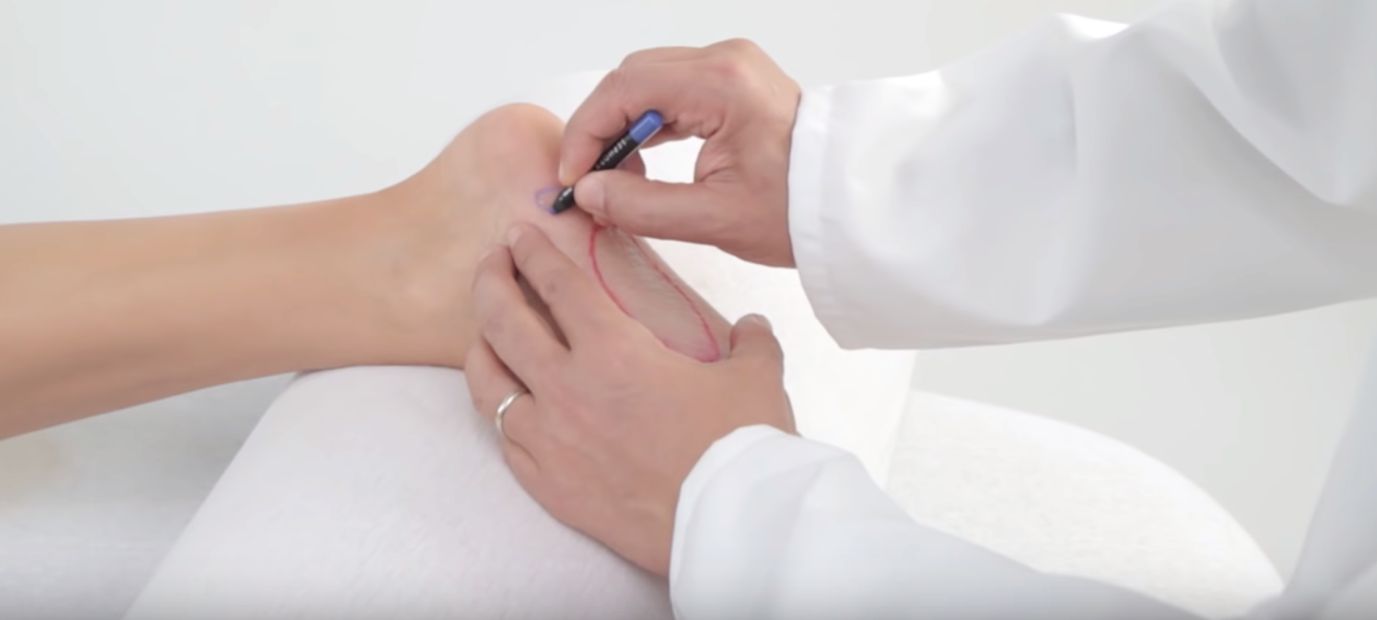Case Study: Plantar Fasciitis Socks – Hit Or Miss?
Do Plantar Fasciitis Socks Exist and are they Beneficial?
A new patient visited the Sydney Heel pain clinic struggling with plantar fasciitis for at least 17 months, and presented to the podiatrist a pair of plantar fasciitis socks. She informs the podiatrist that she has been on some medical merry go round for several months and recently resulted to purchasing socks online after seeing them advertised through social media. The patient was suffering with plantar fasciitis and her left and right foot and this was causing significant heel and arch pain in both feet. This patient was approximately 20 kilos overweight and confesses to the podiatrist that she wishes to begin exercising but she is unable to do so due to the severe pain in both of her feet. She feels frustrated because she would like to lose weight and exercise but is unable to do so as both of her feet hurt. In addition to purchasing the plantar fasciitis socks this patient had paid a visit to her GP, foot specialist, physiotherapist, chiropractor, naturopath and two podiatrists. The podiatrist at the Sydney Heel Pain Clinic being the third podiatry consultation that this patient had attended in at 12 months period.
This patient had been given cortisone injections on two separate occasions into both of her feet and her platter fasciitis persisted. The physiotherapist who she paid a visit to encouraged strength training and a long list of exercises- none of which relieved her symptoms.
This patient reported a significant pain after she had been seated for long periods and would also experience a throbbing sensation if she was sitting or lying in her bed. The throbbing sensations more troublesome in her left foot compared to her right foot and she reports being left side dominant. Frustrated with the pain this patient would use one frozen bottle of water and roll her arches across it on a day today basis. She had heard about plantar fasciitis socks through social media but had avoided purchasing these in favour of more mainstream treatments.
The foot specialist that the patient had paid a visit to instructed her to persist with more conservative treatments and advised the patient that he would not perform surgery as a first line of treatment. He was unable to comment on the efficacy of the plantar fasciitis socks. This patient did spend some time with her GP and was referred for imaging. The reports that this patient received confirmed that there was no heel spur but that the plantar fascia was thinking and calcified, which is typical of plantar fasciitis.
The patient purchased plantar fasciitis socks online and began to where them immediately. She advised the sports podiatrist that she felt quite secure due to the pressure that the socks applied to the arches of her feet. It is quite likely that the benefit felt from the socks was simply you to desensitisation of the nerve endings due to the hugging effect of these socks. The patient also went to bed with the socks on but had to remove them at approximately 2:00 a.m due to them feeling too restrictive. She removed the plantar fasciitis socks and the next morning when she woke from her bed she did report a slight improvement in general foot pain. She describes to the sports podiatrist that it is difficult to say whether or not a plantar fasciitis socks actually reduced the symptoms of the condition itself, or more over they were just relieving general foot fatigue and soreness. Due to these small changes, the patient became hopeful and continued the day-to-day use of her plantar fasciitis socks. However, she decided not to use them at bedtime due to the discomfort.
The patient also reported that while she was using the plantar fasciitis socks she was also mindful that she had increased the frequency of her calf stretches. She began to become confused and was not sure which one of the two therapies was helping. To this end, she stopped stretching her calf muscles and allowed the plantar fasciitis socks to act as the main treatment.

As is usually the case with plantar fasciitis, the symptoms of this condition fluctuated greatly from day to day. Typically, patients with plantar fasciitis will have good and bad days without rhyme or reason. The increase or decrease in symptoms can sometimes be due to the number of steps taken in a day, the choice of footwear used from day to day or even things such as body temperature due to changes in the weather which can affect circulation. Patients who are attempting to resolve the condition are unable to put their finger on what is helping or what is making things worse. This patient continued to use her plantar fasciitis socks for 7 weeks before coming to the conclusion that there did not seem to be a significant improvement. This is likely due to the fact that plantar fasciitis responds to high levels of support which unloads the plantar fasciitis. It can be said that there is insufficient unloading of the plantar fascia and insufficient support from the plantar fasciitis socks, and to this end this is probably the reason why the socks were not particularly beneficial.
The sports podiatrist at the Sydney Heel Pain Clinic explained the benefits of unloading the plantar fascia to the patient and offered to treat her with either rigid sports tape to strap the feet or customised orthotics to unload the plantar fascia.
Treatments Other Than Plantar Fasciitis Socks That Have Been Tried and Tested
The podiatrist explained to the patient that the orthotics would be the most reliable and effective way to support the plantar fascia and that they would be more effective than the plantar fasciitis socks. The sports podiatrist also explained the benefits of shockwave therapy, https://sydneyheelpain.com.au/shock-wave-therapy/ , and due to the fact that this patient had to be struggling for a long period of time, she presented as an ideal candidate for shock wave therapy which would break down some of the scar tissue and therefore promote the turnover of new healthy collagen. The shock wave therapy also acts to stimulate blood flow and has been proven to increase the number of small blood vessels in the area. These more scientific treatments which have undergone more research present as more effective and more reliable treatment options than treatments found online such as plantar fasciitis socks. However, this is not to say that plantar fasciitis socks may not be useful for some people either with heel pain or other foot related conditions.
Lack of Research Into the Efficacy of Plantar Fasciitis Socks
More research is probably needed into the effect of plantar fasciitis socks before it can be conclusively claimed that they are in effective. It would be important to exclude a large number of variables when trying the socks such as footwear, number of steps taken in a day, level of activity, type of sporting activity engaged in, body weight, gender and other medical conditions that can affect the foot.
It can be concluded from this case study that there are more reliable treatment options for plantar fasciitis than the use of plantar fasciitis socks. At tthis stage, the podiatrists at the Sydney Heel Pain Clinic do not, and do not plan to stock plantar fasciitis socks due to the lack of scientific research associated with the product. However, this is not to say that an individual should not try the socks if they have foot related conditions. Perhaps the socks may be beneficial for some people with general foot fatigue or other conditions, but they may not be beneficial in the treatment of plantar fasciitis.
Please be aware that the information contained in this case today should not be taken as general medical or podiatry advice. If you have plantar fasciitis or if you wish to receive treatment for the condition you should probably consult with a suitably qualified sports podiatrist or sports medicine doctor. Please be mindful of the above information before purchasing or using plantar fasciitis socks.
This article was written by Karl Lockett of Sydney Heel Pain Clinic
This image below involves the use of the Swiss Dolorclast machine for shock wave therapy
https://sydneyheelpain.com.au/shock-wave-therapy/
Written by Karl Lockett

